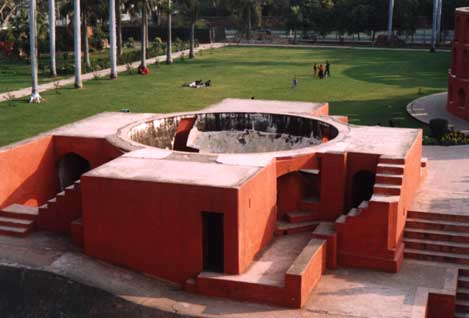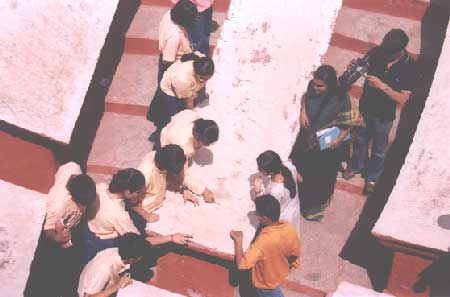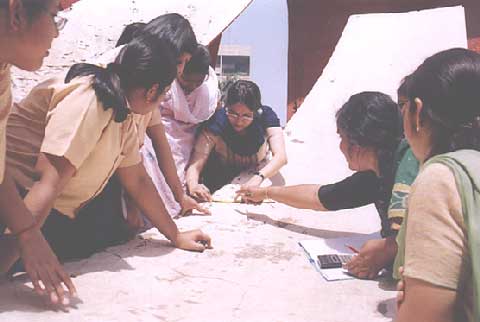|
|
Venus2004.org
> Files
2°) Observations from the Jayaprakas
The Jayaprakas consists of twin hemispherical bowls placed facing the sky - each a reflection of the sky above and marked in sectors and gap regions. The bowls are complementary, in the sense that, the gap region in one bowl is the sector region in the other and vice versa. The idea being that, the observer needs to be inside the bowl, to take readings - which means that readings would not be possible in the regions where the observer would be able to walk - and hence the complimentary bowl.  Figure 1. The southern bowl of the Jayaprakas instrument at the Delhi Jantar Mantar. © Nehru Planetarium, New Delhi, India. How does the instrument work? At the surface level on the depressed bowl - There are pegs in the North-South and East-West direction to hold cross wires. One has to view the shadow of the junction of the cross wires on the bowl of the instrument to determine the co-ordinates of the Sun in the daytime sky. The sectors on the surface of the hemisphere are marked with altitude and azimuth circles, the tropics and intermediate circles and also circles of the signs of Zodiac. In the Delhi instrument most of these markings are rubbed off. The Altitude and Azimuth circles towards the center of the bowl are still visible, so that Sun measurements in local co-ordinates, close to the Noon time are still relatively easy. For measurements at other times and for Equatorial co-ordinate or elliptical co-ordinate measurements more rigorous calibration will be needed.  Figure 2. An interior view of the bowl of the Jayaprakas instrument.. © Nehru Planetarium, New Delhi, India. Plastic wire was used for making a makeshift cross-wire for the Jayaprakas. Once the crosswires were in place, one had to observe for the shadow of the intersection of the two wires to fall on the bowl of the instrument. Jayaprakas measurements were done once in the morning on the 29th of March 2004 - we had with us theoretical values for every half hour - so that students could immediately check their values for accuracy.  The lattitude of Delhi - 28 degrees - 0 - Jantar Mantar © Nehru Planetarium, New Delhi, India. Azimuth readings were easier - and fractions of degrees were read off from the existing markings by placing tape measure parallel to Azimuth circles. Altitude readings were taken by measuring the radial length to the location of the shadow of the cross wire and using the entire sector length for calibration - from center to the surface of the hemisphere being 90 degrees of altitude - the compliment of it actually - as an altitude of 90 degrees would mean the shadow falling at the center of the bowl and an Altitude of Zero when the shadow would fall at the surface of the hemisphere.  Figure 3. Students marking the cross wire shadow in the Jayaprakas.© Nehru Planetarium, New Delhi, India. Some of the Jayaprakas Observational results – (Observations of Altitude and Azimuth of the Sun - taken by students of Sanskriti School, New Delhi, on the 29th of March 2004).  The Calculated values have used the co-ordinates for the Jantar Mantar as 280 37’ 36” North Lattitude and 770 13’ East Longitude. |
|
© 2003-2006 Futura-Sciences.com. All rights reserved.
Indexator - Comparateur de prix - Revue de Presse
